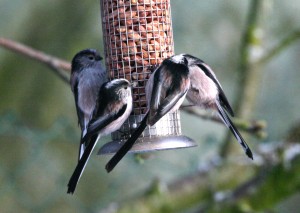 There is something fascinating about long-tailed tits, perhaps because of the tiny body contrasting with the ridiculously long tail. For example the length of the bird is 14 cm of which the tail is 9 cms. The weight of the bird is only 8 gms and to put this into scale a two pence coin weighs 7 gms. Last week I was watching a flock of 12 long-tailed tits in the garden and they favoured the round suet balls in their special feeder. I say favoured as there was no way 12 could get on the one suet feeder so some had to suffice with the peanuts in the feeder nearby. The photograph shows the “overspill” on the peanut holder and the birds are difficult to photograph as they are constantly on the move. The flock of 12 stayed some time and as dusk gathered it was soon obvious that they would be the last birds to go to roost that afternoon. These birds are likely to have been related and will form a strong bond during the winter months ahead. They roost communally and will often form a line on a branch with feathers huffed up and pressed close together to add warmth.
There is something fascinating about long-tailed tits, perhaps because of the tiny body contrasting with the ridiculously long tail. For example the length of the bird is 14 cm of which the tail is 9 cms. The weight of the bird is only 8 gms and to put this into scale a two pence coin weighs 7 gms. Last week I was watching a flock of 12 long-tailed tits in the garden and they favoured the round suet balls in their special feeder. I say favoured as there was no way 12 could get on the one suet feeder so some had to suffice with the peanuts in the feeder nearby. The photograph shows the “overspill” on the peanut holder and the birds are difficult to photograph as they are constantly on the move. The flock of 12 stayed some time and as dusk gathered it was soon obvious that they would be the last birds to go to roost that afternoon. These birds are likely to have been related and will form a strong bond during the winter months ahead. They roost communally and will often form a line on a branch with feathers huffed up and pressed close together to add warmth.
One of the most remarkable aspects about the long-tailed tits is the nests they build. It is domed and oval and for camouflage the outer part is a mixture of lichens and mosses, a perfect camouflage in the middle of a shrub or hedge. Inside the nest is even more surprising as the inner lining, to hold the six to eight eggs, is built up with around 2,600 small feathers. The birds are able to regulate the temperature of the inner part of the nest, so essential for brooding eggs and chicks, by judging the number of feathers which they add or discard. The breeding season holds another appealing trait as if for any reason a pair of birds lose their nest and/or eggs they do not give up for that season. Instead they join in with other pairs that have been more successful. They will help not only help in building a nest but also in feeding the offspring from another pair. This leads to a great bond between long-tailed tits all the year round. Large flocks of long-tailed tits can be seen in the winter and their constant call notes are contact calls to keep the birds together. The large flocks means that once a food source is found then all the bird benefit. Large number of birds also means more eyes to keep open to see any predators such a sparrowhawk.
There is evidence that part of the long-tail tits breeding success in recent years is the number of people who feed garden birds. At one time these birds were entirely insectivorous but then there seem to be a subtle change, especially in the winter months. Whether they found insects on peanut feeders or the suet balls is uncertain but now they are attracted to both peanuts and suet balls during the winter months. However, there is still a need for plenty of insects in the summer as this forms the bulk of the food for nestlings and young juveniles alike. They now nest virtually anywhere in Scotland wherever there are bushes for their nests. They have even spread to the Western Isles and there are estimate to be between 30,000 and 45,000 pairs in Scotland. Their biggest threat is severe winters which is why the comparatively mild winters of recent years has been beneficial to them.
Tags: highland birds
